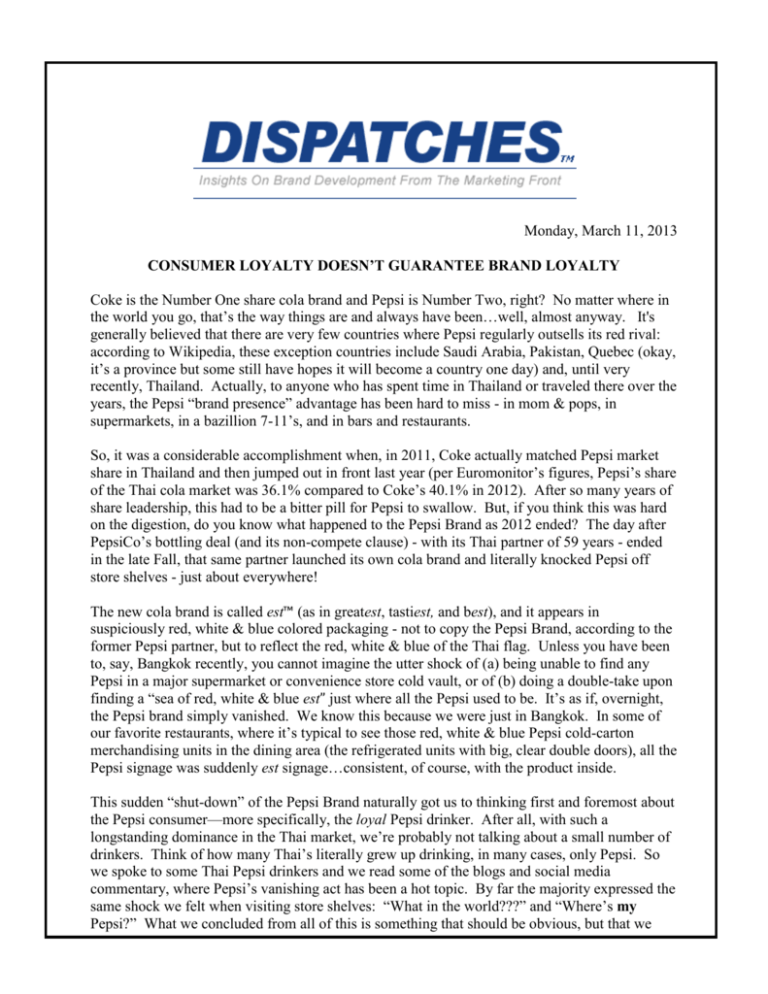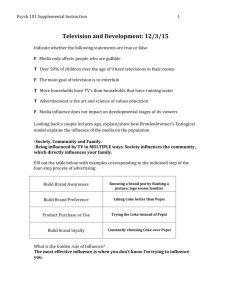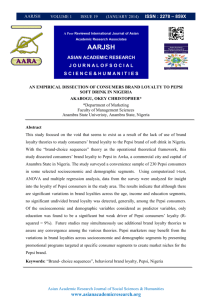
Monday, March 11, 2013
CONSUMER LOYALTY DOESN’T GUARANTEE BRAND LOYALTY
Coke is the Number One share cola brand and Pepsi is Number Two, right? No matter where in
the world you go, that’s the way things are and always have been…well, almost anyway. It's
generally believed that there are very few countries where Pepsi regularly outsells its red rival:
according to Wikipedia, these exception countries include Saudi Arabia, Pakistan, Quebec (okay,
it’s a province but some still have hopes it will become a country one day) and, until very
recently, Thailand. Actually, to anyone who has spent time in Thailand or traveled there over the
years, the Pepsi “brand presence” advantage has been hard to miss - in mom & pops, in
supermarkets, in a bazillion 7-11’s, and in bars and restaurants.
So, it was a considerable accomplishment when, in 2011, Coke actually matched Pepsi market
share in Thailand and then jumped out in front last year (per Euromonitor’s figures, Pepsi’s share
of the Thai cola market was 36.1% compared to Coke’s 40.1% in 2012). After so many years of
share leadership, this had to be a bitter pill for Pepsi to swallow. But, if you think this was hard
on the digestion, do you know what happened to the Pepsi Brand as 2012 ended? The day after
PepsiCo’s bottling deal (and its non-compete clause) - with its Thai partner of 59 years - ended
in the late Fall, that same partner launched its own cola brand and literally knocked Pepsi off
store shelves - just about everywhere!
The new cola brand is called est™ (as in greatest, tastiest, and best), and it appears in
suspiciously red, white & blue colored packaging - not to copy the Pepsi Brand, according to the
former Pepsi partner, but to reflect the red, white & blue of the Thai flag. Unless you have been
to, say, Bangkok recently, you cannot imagine the utter shock of (a) being unable to find any
Pepsi in a major supermarket or convenience store cold vault, or of (b) doing a double-take upon
finding a “sea of red, white & blue est” just where all the Pepsi used to be. It’s as if, overnight,
the Pepsi brand simply vanished. We know this because we were just in Bangkok. In some of
our favorite restaurants, where it’s typical to see those red, white & blue Pepsi cold-carton
merchandising units in the dining area (the refrigerated units with big, clear double doors), all the
Pepsi signage was suddenly est signage…consistent, of course, with the product inside.
This sudden “shut-down” of the Pepsi Brand naturally got us to thinking first and foremost about
the Pepsi consumer—more specifically, the loyal Pepsi drinker. After all, with such a
longstanding dominance in the Thai market, we’re probably not talking about a small number of
drinkers. Think of how many Thai’s literally grew up drinking, in many cases, only Pepsi. So
we spoke to some Thai Pepsi drinkers and we read some of the blogs and social media
commentary, where Pepsi’s vanishing act has been a hot topic. By far the majority expressed the
same shock we felt when visiting store shelves: “What in the world???” and “Where’s my
Pepsi?” What we concluded from all of this is something that should be obvious, but that we
marketers may sometimes overlook: namely, Brand Loyalty requires more than winning the
hearts and minds of potential consumers. You must have that sustained availability. And, at
least in the case of how most soft drinks go to market, that means you must also have the Brand
Loyalty of your business partners.
We don’t know what all the factors were that contributed to the erosion of the business
partnership between PepsiCo and its 59-year Thai partner. Some website articles have referred
to a failed hostile takeover by PepsiCo in 2010. Then, too, losing longtime market share
leadership to Coke in 2011 couldn’t have helped the situation. But, whatever the behind-thescenes causes, it’s clear that the decades-long relationship between the Company/ Pepsi Brand
and its local business partner had deteriorated…regardless of a decades-long relationship
between the Pepsi Brand and many Thai consumers that remained alive and well. Hmmmmmm.
So achieving and sustaining brand loyalty is about more than just the fundamental relationship
between Brand and Consumer. When you think about it, this is true in virtually every market;
for example, pharmaceutical marketers know only too well that, without the loyal relationship
between doctor-prescriber and the Company/ Brand, there is no way any consumer-patient can
develop a loyal relationship with the drug.
Again, you may say, “Well, sure, isn’t this obvious, a no-brainer?” It may be. But for us, the big
“aha” in the Pepsi-Thailand story is that brand-builders and marketers need to think regularly
about how to better sustain brand loyalty among all the Brand’s key constituencies. Of course,
most companies rely on their Sales Force or their Distributor Relations group to sustain or build
brand availability and to merchandise the brand at retail. But we think Marketing needs to have
a place at this table as well—by (1) making it a practice to get out, interact with, and listen to
wholesalers, distributors, and key account customers often, and by (2) innovating with programs
and brand-support materials that will keep the Brand as exciting to them as it is to the enduser…to keep all the Brand’s relationships strong… and LOYAL!
BOATS & HELICOPTERS - How Do You Measure Brand Loyalty?
1.
Given that brand loyalty is, for most brands, about more than just one constituency’s
relationship with the brand (i.e., the consumer/ end-user’s), there ought to be at least one
good method for measuring the strength of each constituency’s loyalty. One simple way
that some fast-moving consumer brands use is tracking purchase frequency—the idea
being that, if a consumer buys a one brand for nearly all of his annual occasions, he can
be considered relatively loyal. In pharmaceuticals, brands also track the frequency of a
doctor’s prescription-writing for a specific drug.
2.
Then there are some “purists” who insist that the true measure of a consumer’s brand
loyalty (the “acid test,” so to speak) relates to her degree of insistence. While not so
easily measured, this method is based upon how much trouble the consumer will go to
get “her brand.” In other words, if, upon shopping at a regular spot, she finds her brand
out-of-stock, she would be considered truly loyal by going out of her way to find
another store where her brand is currently available.
3.
But, reflecting upon the Pepsi-Thailand situation, perhaps there is an even more
demonstrative “acid test” of a consumer’s loyalty: how quickly he or she comes back to
regular purchase after the brand has regained lost availability. Despite Pepsi’s
2
significant loss of distribution in many Thai outlets, it still seems that the pent-up
demand for “my Pepsi” is strong.
4.
What about measuring the loyalty of key business partners? To be sure, marketers must
rely a lot on the qualitative “pulse feel” supplied by the Sales Force. But, as we noted,
it’s also important for Brand Marketers to get their own, regular “pulse-feel” from their
brand’s business partners.
Whatever the method, staying on top of all the Brand’s loyal relationships is a must for
marketers today.
Richard Czerniawski & Mike Maloney
Richard Czerniawski
........................................................
430 Abbotsford Road
Kenilworth, Illinois 60043
tel 847.256.8820
fax 847.256.8847
........................................................
reply to Richard:
rdczerniawski@cs.com or
richardcz@bdn-intl.com
Mike Maloney
....................................................
1506 West 13th Street, #17
Austin, Texas 78703
tel 512.236.0971
fax 512.236.0972
.....................................................
reply to Mike:
mikewmaloney@gmail.com or
mwm@bdn-intl.com
Please forward any comments regarding the newsletter to Lori Vandervoort at our
Central Division Offices of BDN International, 800-255-9831 or 620-431-0780.
lorivan@bdn-intl.com
International
© 2003 Brand Development Network (BDN) International. All rights reserved.
3








